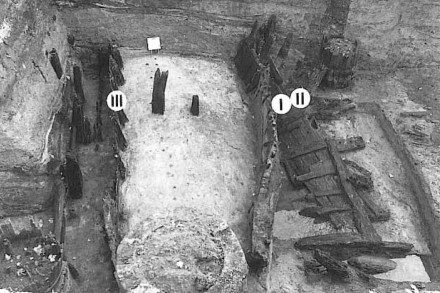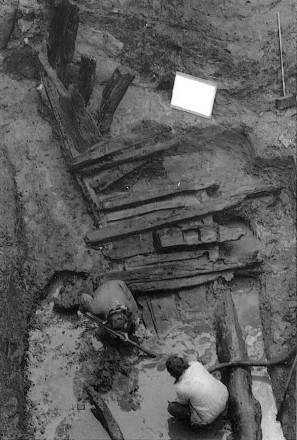History
In 1983, remains of ships were found during archaeological research in the IJsselstraat in the Dutch city of Deventer.
Three medieval quay works that were placed parallel to the river IJssel were found. In these, wooden ship fragments had been reused as revetments. Artefacts found in the vicinity (earthenware) date the embankments between the tenth and the twelfth century. This way of constructing quays with parts of old ships was common in the area in the Middle Ages. The archaeological ship remains were named Deventer I, II and III.
A second barge fragment was found close to the Deventer I fragment, measuring 4.5 by 2.4 meters.

Description
The fragment consists of a wide bilge board (70 to 75 cm) with a beveled thickening. There is a remainder of planking attached at the chine. Seven fasteners and two pinewood trusses remain from the attachment. One of the frames is extra robust with a recess for a mast base. The bottom was probably carvel built. A repair piece has been applied in the buttock area with iron nails.
The cross-section of the chine shows that half of a 1.5 meter thick tree has been used. The oak wood frames consists of a broad (trunk) surface with an upright side branch as a truss. The seams are caulked with moss and secured with iron (sintel) nails.
The Deventer II fragment shows traces of long-term use. The overall finish and the moderate quality of the used wood (a lot of sapwood) indicates that the ship was made quickly. The ship probably burned out. The remains were used for quay protection.
Dendrochronological analysis provides a logging date for the wood around 1035. The wood came from the Ardennes.

Status

References
- Vlierman, K. (1996), Kleine bootjes en middeleeuws scheepshout met constructiedetails, Lelystad (Flevoberichten 404/Scheepsarcheologie II).
- E. Mittendorff (2017).
Publicaties Archeologische Depot Overijssel 6 - Tussen Wal en schip. - W. Brouwers/E. Jansma/M. Manders (2015).
Middeleeuwse scheepsresten in Nederland.
Archeo, 2015 (3).
pp 6-24.